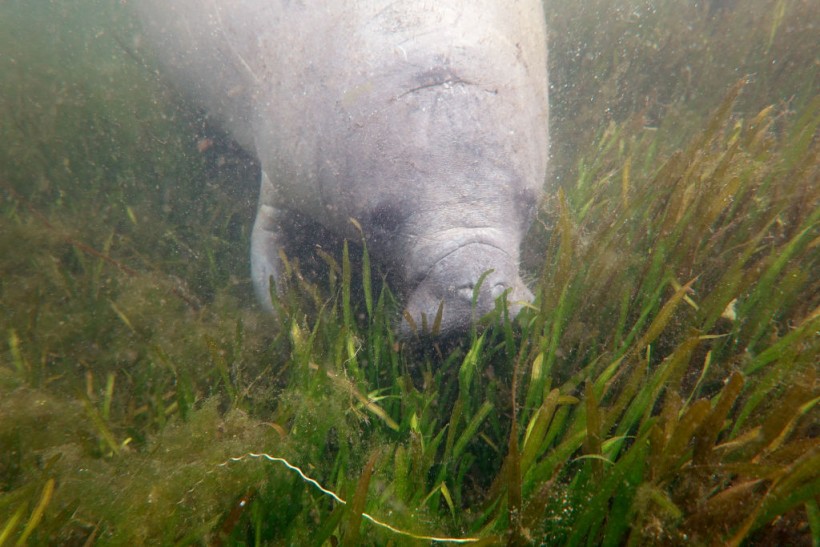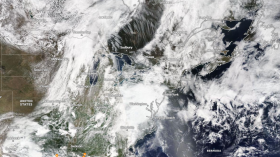Nearly 10% of Florida manatees had died during the first nine months of 2021 - this is more than double the five-year average of manatee deaths.
Being moved from the endangered species list in 2017 to threatened, this event had put significant threat to the migratory species, congregating mainly in the waters of Florida, where water quality issues were reported to have disrupted the primary food sources they mainly rely on. Moreover, threats from boat strikes, habitat loss and toxic algae blooms are big factors, including massive deaths from simple starvation.
According to NewsBreak, the Florida Fish and Wildlife Conservation Commission (FWC) officials help stave off this starvation by "throwing off" 3000 pounds of lettuce a day into the sea, and officials say the feeding program had helped significantly so far.
The sea cows' "salad bar"

HOMOSASSA, FLORIDA - OCTOBER 05: A manatee swims among seagrass in the Homosassa River on October 05, 2021 in Homosassa, Florida. Conservationists, including those from the Homosassa River Restoration Project, plant seagrass in the area to help restore the natural habitat for manatees and provide a feeding ground for the mammals, following a record year in manatee deaths in Florida. The deaths were primarily from starvation due to the loss of seagrass beds.
Florida Manatees mostly feed on seagrass found in the northern Indian River Lagoon and Banana River, rivers which served as their winter homes for a long time.
The unprecedented decline in seagrass ecosystem smothered by pollutants, along with toxic blooms intensified by climate change, made the end of 2021 "one of the worst years for manatees ever", Environment America reported.
WUSF Public Media had recorded more than half of the deaths in the Indian River Lagoon and some 20% of the manatee population has been wiped out on Florida's east coast.
To date, more than 50,000 pounds of donated lettuce have been fed to the starving manatees to keep them alive this winter, a program directed by FWC. Over 350 manatees are currently coming to a temporary field response station in Cape Canaveral to get their daily servings of romaine and butter lettuce.
"We are exposing large amount of animals to this food source and we are making a difference," Ron Mezich of the FWC told CNN. "The lettuce has nutrients and digestible carbohydrates the sea cows need," he added.
Also read: 170 Wild Elephants to be Auctioned in Namibia Due to Uncontrollable Growing Population
Restoring manatee's endangered status
Experts say that the U.S. Fish and Wildlife Service (USFWS) neglected scientifically documented warning signs that manatees were in trouble at the time it downlisted the animal from endangered to threatened.
"If you don't believe it's a serious issue and it's going to be a short-term problem, you're not going to put the scientific effort into it, or the political effort, or the management practices into place to prevent those declines in the future," said Pat Rose, an aquatic biologist who has spent 40 years with Save the Manatee Club.
To ensure that 2022 will be a better year for the dying creatures, it is critical that their habitat will be protected and a recovery plan will be administered by the agency itself. USFWS acknowledged the concerns and noted that the animal could be reclassified again as endangered, should conditions change.
"Especially in the wake of several major die-offs," wrote peer-reviewer John Reynolds, senior scientist at Mote Marine Laboratory, "it seems possible, and perhaps even likely, that life history parameters of Florida manatees may change for the worse in the near future."
Also read: Demand for Chinese Traditional Medicine Fuels Illegal Wildlife Trafficking in Africa
© 2024 NatureWorldNews.com All rights reserved. Do not reproduce without permission.



![Venomous Centipede Could be Game-Changer and Save Lives of People with Kidney Disease [Study]](https://1471793142.rsc.cdn77.org/data/thumbs/full/70407/280/157/50/40/venomous-centipede-could-be-game-changer-and-save-lives-of-people-with-kidney-disease-study.jpg)

